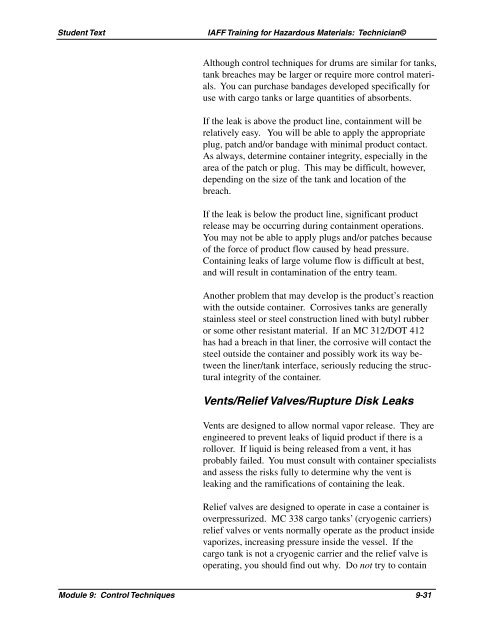Module 9: Control Techniques - International Association of Fire ...
Module 9: Control Techniques - International Association of Fire ...
Module 9: Control Techniques - International Association of Fire ...
You also want an ePaper? Increase the reach of your titles
YUMPU automatically turns print PDFs into web optimized ePapers that Google loves.
Student Text IAFF Training for Hazardous Materials: Technician©<br />
Although control techniques for drums are similar for tanks,<br />
tank breaches may be larger or require more control materials.<br />
You can purchase bandages developed specifically for<br />
use with cargo tanks or large quantities <strong>of</strong> absorbents.<br />
If the leak is above the product line, containment will be<br />
relatively easy. You will be able to apply the appropriate<br />
plug, patch and/or bandage with minimal product contact.<br />
As always, determine container integrity, especially in the<br />
area <strong>of</strong> the patch or plug. This may be difficult, however,<br />
depending on the size <strong>of</strong> the tank and location <strong>of</strong> the<br />
breach.<br />
If the leak is below the product line, significant product<br />
release may be occurring during containment operations.<br />
You may not be able to apply plugs and/or patches because<br />
<strong>of</strong> the force <strong>of</strong> product flow caused by head pressure.<br />
Containing leaks <strong>of</strong> large volume flow is difficult at best,<br />
and will result in contamination <strong>of</strong> the entry team.<br />
Another problem that may develop is the product’s reaction<br />
with the outside container. Corrosives tanks are generally<br />
stainless steel or steel construction lined with butyl rubber<br />
or some other resistant material. If an MC 312/DOT 412<br />
has had a breach in that liner, the corrosive will contact the<br />
steel outside the container and possibly work its way between<br />
the liner/tank interface, seriously reducing the structural<br />
integrity <strong>of</strong> the container.<br />
Vents/Relief Valves/Rupture Disk Leaks<br />
Vents are designed to allow normal vapor release. They are<br />
engineered to prevent leaks <strong>of</strong> liquid product if there is a<br />
rollover. If liquid is being released from a vent, it has<br />
probably failed. You must consult with container specialists<br />
and assess the risks fully to determine why the vent is<br />
leaking and the ramifications <strong>of</strong> containing the leak.<br />
Relief valves are designed to operate in case a container is<br />
overpressurized. MC 338 cargo tanks’ (cryogenic carriers)<br />
relief valves or vents normally operate as the product inside<br />
vaporizes, increasing pressure inside the vessel. If the<br />
cargo tank is not a cryogenic carrier and the relief valve is<br />
operating, you should find out why. Do not try to contain<br />
<strong>Module</strong> 9: <strong>Control</strong> <strong>Techniques</strong> 9-31
















